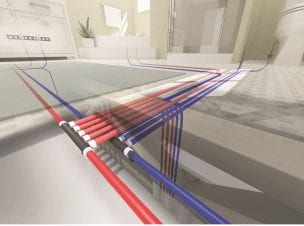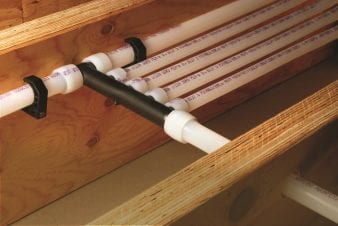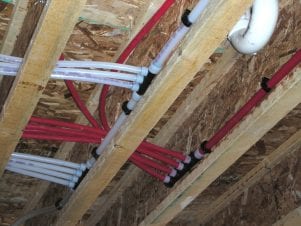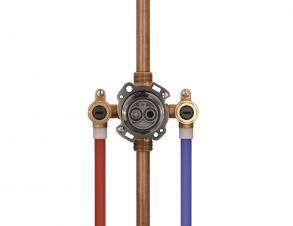As they say in one of the world’s most popular television shows: winter is coming. With winter comes the inevitable rise in the number of burst pipe calls all plumbers will be tasked with repairing. Pipes are generally more likely to burst when the temperature drops below 20 degrees Fahrenheit. It is suggested that those Read more
PEX

 As they say in one of the world’s most popular television shows: winter is coming. With winter comes the inevitable rise in the number of burst pipe calls all plumbers will be tasked with repairing. Pipes are generally more likely to burst when the temperature drops below 20 degrees Fahrenheit. It is suggested that those living in cold-weather climates keep their homes heated to a minimum of 36 degrees if they are not going to be using their water for an extended period of time. However, no matter how present these warnings are, some winter pipe bursts are unavoidable.
As they say in one of the world’s most popular television shows: winter is coming. With winter comes the inevitable rise in the number of burst pipe calls all plumbers will be tasked with repairing. Pipes are generally more likely to burst when the temperature drops below 20 degrees Fahrenheit. It is suggested that those living in cold-weather climates keep their homes heated to a minimum of 36 degrees if they are not going to be using their water for an extended period of time. However, no matter how present these warnings are, some winter pipe bursts are unavoidable.
Fortunately, John Guest has committed time and effort to developing the products necessary to tackle this problem. The John Guest Speedfit slip connectors provide plumbers with a quick, simple, and easy fix for burst pipes.
 Their slip connectors come in two sizes and can be used to fix pipe bursts on PEX, CPVC, and copper pipes, providing an efficient solution to a litany of burst-pipe problems. John Guest slip connectors have push-fit connections, allowing for rapid installation that should at least temporarily solve one of the major issues with burst pipes: leakage. The push-fit fitting allows all of this to be accomplished without any additional pipe work.
Their slip connectors come in two sizes and can be used to fix pipe bursts on PEX, CPVC, and copper pipes, providing an efficient solution to a litany of burst-pipe problems. John Guest slip connectors have push-fit connections, allowing for rapid installation that should at least temporarily solve one of the major issues with burst pipes: leakage. The push-fit fitting allows all of this to be accomplished without any additional pipe work.
Slip connectors are also built to work with both hot and cold pipes, again providing coverage across the entire spectrum of possible burst-pipe issues that one may encounter. John Guest slip connectors are made with lead-free, non-toxic, and non-flammable materials so you can feel secure in installing these connectors for any issue and leave them to run without constant monitoring. Like all John Guest products, the Speedfit slip connectors are made with an advanced polymer material, assuring our customers that they are receiving only the highest-quality performance.
For more visit John Guest Speedfit slip connectors.

When the owners of a 45-year-old, 172-unit apartment building in Austin, Texas, decided to replace their underground plumbing, heating and cooling system after years of leaks and insulation problems, they decided to turn to HHCC, a local Austin general contracting and plumbing firm, to install the new systems. Bill Fowler, president of HHCC, had read Read more
 When the owners of a 45-year-old, 172-unit apartment building in Austin, Texas, decided to replace their underground plumbing, heating and cooling system after years of leaks and insulation problems, they decided to turn to HHCC, a local Austin general contracting and plumbing firm, to install the new systems.
When the owners of a 45-year-old, 172-unit apartment building in Austin, Texas, decided to replace their underground plumbing, heating and cooling system after years of leaks and insulation problems, they decided to turn to HHCC, a local Austin general contracting and plumbing firm, to install the new systems.
Bill Fowler, president of HHCC, had read about the benefits of pre-insulated piping in hydronic repiping jobs, but had not personally used it in any previous projects. Fowler, whose company has installed PEX piping for plumbing solutions for many years, turned to Uponor after reading about the benefits of Ecoflex®, Uponor’s pre-insulated piping system. Both flexible and durable, Ecoflex is equipped with a layered, closed-cell, polyethylene-foam insulation and HDPE corrugated outer jacket providing long-term and efficient solutions for retrofit projects.
“This project is one of the most challenging and difficult underground jobs we have ever done,” Fowler said. “It was a priority to keep residents living in their apartments during the installation, so we had to keep the existing plumbing systems functioning while installing the new systems.” To further complicate the installation, Austin saw an unprecedented amount of rain during the three months of the initial installation, making the installation more challenging. With the saturated and soaked grounds, the piping had to be put in immediately after a trench was excavated, and then quickly backfilled before the trench would collapse.
 In addition, the installers had to weave over and under existing underground utilities. “There were so many existing water, sewer, hydronic pipes and hi-voltage electric, telephone and cable TV lines buried, forcing us to hydro-excavate most areas,” Fowler said. “Ecoflex allowed our installation crew to weave over, under, around and through this maze of existing utilities.”
In addition, the installers had to weave over and under existing underground utilities. “There were so many existing water, sewer, hydronic pipes and hi-voltage electric, telephone and cable TV lines buried, forcing us to hydro-excavate most areas,” Fowler said. “Ecoflex allowed our installation crew to weave over, under, around and through this maze of existing utilities.”
HHCC took advantage of Uponor’s Design Services department to design the most economical way to install the system. According to Fowler, the most labor-intensive part of the job was the excavation and back-filling while the Ecoflex pipe installation was the easiest part of the job. “We saw large savings in labor costs,” Fowler said, “beating our initial labor estimate by quite a bit.”
Ecoflex is available in long lengths – up to 600-foot coils, and Fowler said this was another advantage for them during the installation. “The long rolls eliminated the need for additional joints that go along with a conventional piping job, providing a smaller installation crew and better flow qualities,” he said.
 And with nearly two miles of Ecoflex going into this project, Fowler admitted that he was a bit overwhelmed when the large amount of pipe needed for the hydronic and potable hot-water installations showed up on the job. “The 600-foot rolls are quite large,” Fowler said. “But Uponor’s support staff visited the site and showed us best installation practices, and their engineering staff was readily available to answer questions and provide flow calculations for our mechanical engineer when he needed help.”
And with nearly two miles of Ecoflex going into this project, Fowler admitted that he was a bit overwhelmed when the large amount of pipe needed for the hydronic and potable hot-water installations showed up on the job. “The 600-foot rolls are quite large,” Fowler said. “But Uponor’s support staff visited the site and showed us best installation practices, and their engineering staff was readily available to answer questions and provide flow calculations for our mechanical engineer when he needed help.”
“I have come to believe that Ecoflex is a superior product in underground hydronic and domestic-water installations,” Fowler said. “The insulation, the flexibility, the large-diameter expansion fittings and the long lengths that virtually eliminate the need for underground joints, all contribute to make this the most viable product of its kind on the market today.”

For residential plumbers, there have been two schools of thought for plumbing a house: home run and trunk and branch. Both have their positives and negatives, depending on what you’re trying to accomplish with the plumbing system. However, you may not know there’s a new (and smarter) way to design and install a residential plumbing Read more
 For residential plumbers, there have been two schools of thought for plumbing a house: home run and trunk and branch. Both have their positives and negatives, depending on what you’re trying to accomplish with the plumbing system.
For residential plumbers, there have been two schools of thought for plumbing a house: home run and trunk and branch. Both have their positives and negatives, depending on what you’re trying to accomplish with the plumbing system.
However, you may not know there’s a new (and smarter) way to design and install a residential plumbing system that installs faster, uses less materials, requires fewer connections, minimizes your liability and operates more efficiently.
It’s called Logic plumbing.
A Logic plumbing design can only be used with PEX piping, but since PEX is now used in more new-home construction than copper and CPVC combined, you’re most likely already using it. (And if you’re not, you need to check it out. PEX is highly durable, flexible and more cost-effective compared to copper and CPVC.)
The Logic approach leverages the flexibility of PEX pipe to minimize connections and reduce potential leak points while also incorporating multiport tees located near fixture groupings to both limit the amount of pipe and connections needed while also improving installation efficiencies and system performance.
What’s a multiport tee?
I’m sure right now you’re wondering, “What’s a multiport tee?” It’s essentially a bunch of tees all molded together to create one long tee with multiple outlets. This innovative product minimizes connections and is the heart and soul of a Logic design.
 For example, six regular tees will have 18 connections, but a flow-through multiport tee with six outlets will only have eight connections (six connections for the ports, a main flow-through inlet and a main flow-through outlet). Think about how much faster you could install a system when you’re making half the number of connections.
For example, six regular tees will have 18 connections, but a flow-through multiport tee with six outlets will only have eight connections (six connections for the ports, a main flow-through inlet and a main flow-through outlet). Think about how much faster you could install a system when you’re making half the number of connections.
And get this — while multiport tees may resemble a manifold, they have the benefit of being hidden behind walls without the need for an access panel. Yes, you heard that right. No need for an access panel, minimizing costs and labor to help keep your projects on schedule and on budget.
Multiport tees are made of engineered polymer (EP), a thermoplastic material that has been used in plumbing applications for more than 20 years. EP has superior mechanical, chemical and thermal properties that provide dimensional stability in demanding applications, including areas of high stress, heat and moisture.
And, like PEX, the EP material in multiport tees resists corrosion, pitting and scaling, so it creates a highly durable system that’s engineered to last. Best of all, multiport tees (as well as all EP fittings) are approved for direct burial in the soil or concrete slab, so they are ideal for in-slab plumbing applications.
The Logic layout
So what exactly is a Logic plumbing layout? It’s quite simple: a main line connects to a multiport tee with distribution lines going out from the tee. These individual lines extending from the single multiport tee provide water to all fixtures in a single or adjacent grouping.
 This design uses significantly less pipe than a home-run layout, with just a few more connections. Plus, it requires considerably fewer connections compared to a trunk-and-branch installation.
This design uses significantly less pipe than a home-run layout, with just a few more connections. Plus, it requires considerably fewer connections compared to a trunk-and-branch installation.
For example, a 2,300-square-foot, two-story home using a Logic design requires only 637 feet of pipe while a home-run system uses 1,515 feet of pipe. That’s more than twice the amount of piping necessary.
In addition to the added costs required to install all that extra pipe, the system performance is also greatly reduced due to added pressure loss and longer wait times for hot water. Plus, all the extra pipe can lead to issues isolating hot and cold water lines. This increases heat transfer and energy inefficiencies within the plumbing system.
And, while it’s true a Logic installation uses slightly more connections than a home-run layout (59 vs. 48 in the 2,300-square-foot, two-story home example above), the amount of pipe savings is significantly more beneficial with the labor and material savings you get with less pipe to install (not to mention the efficiency of the system).
A Logic layout also installs much faster compared to a trunk-and-branch system due to the vast reduction in connections. With the two-story home example above, a Logic layout uses a mere 16 fittings and 59 connections compared to a whopping 96 fittings and 165 connections for trunk and branch. That’s six times the number of fittings and nearly three times the amount of connections!
All those added connections greatly increase your liability with more potential for leaks, plus it also limits the performance of the system with increased pressure loss.
So there you have it! Just a few “logical” reasons why you should consider a smarter approach to plumbing a home that will improve your installation times, limit your liability and offer an all-around better-performing system for the end user.

Kim Bliss is the content development manager at Uponor. She can be reached at kim.bliss@uponor.com.

Gerber, a leader in plumbing products across North America, has launched one of the industry’s most innovative and flexible tub and shower valves. In an effort to help professionals work smarter, not harder, the new Treysta™ rough-in valve system is built to accommodate varying requirements plumbers face on site in a range of installations. “We’ve Read more
 Gerber, a leader in plumbing products across North America, has launched one of the industry’s most innovative and flexible tub and shower valves. In an effort to help professionals work smarter, not harder, the new Treysta™ rough-in valve system is built to accommodate varying requirements plumbers face on site in a range of installations.
Gerber, a leader in plumbing products across North America, has launched one of the industry’s most innovative and flexible tub and shower valves. In an effort to help professionals work smarter, not harder, the new Treysta™ rough-in valve system is built to accommodate varying requirements plumbers face on site in a range of installations.
“We’ve worked tirelessly to perfect this valve, fine-tuning it based on input and testing of plumbing professionals in the field,” says Katie Hayes, senior product manager. “With more than 85 years of experience to draw upon, we’re proud to incorporate the Gerber performance and reliability into this product that people have come to expect from all our products.”
Treysta Features and Benefits
Multiple features within the new valve system are patent pending. A complete list of features and benefits include:
- Revolutionary Vertical Inlets – Treysta’s vertical inlets allow for maximum flexibility in the wall, and can install next to a stud in PEX applications greatly reducing the need for re- framing
- Easy Installation and Access – With an easy-access mounting system and an innovative plaster guard with integrated depth indexing, Treysta is engineered for smooth and quick installation
- Intuitive Quarter-turn Service Stops – Treysta features quarter-turn service stops that open and close with a flat head screw driver in the slot or pliers on the flat sides for ease of maintenance
- Easy Pressure Testing Capability – The unique, reversible test plug accommodates full system tests, as well as hot, cold and cross-flow tests
- Flexible and Adaptable for Different Environments – Treysta has a solution for “with” and “without” stops, and accommodates back-to-back installations and reversed hot and cold inlets, as well as IPS / sweat, Cold Expansion PEX, and Crimp PEX applications
- Secure and Level Mounting – The compact, brass-forged body of the valve features integrated mounting holes for a firm and secure hold, and the flat top plane of the plaster guard allows it to install level with the floor
- Innovative Common Platform – Treysta uses a common platform of pressure balance cartridge for all configurations, meaning a single cartridge fits in all valve bodies
- Fully Compatible Danze® by Gerber Trim – Danze by Gerber trim has been updated to include the Treysta pressure balance cartridge, which will ultimately minimize cartridge damage during rough-in installation
For more information about the Treysta valve from Gerber, visit treysta.gerberonline.com.

Designed for sustainable underground or under-slab fluid transfer in a variety of hydronic heating, cooling and potable-water systems, Uponor Ecoflex® is an easy-to-install, dependable, energy-saving solution for any residential or commercial application. Available with service pipe from 1″ up to 4″ and insulation thicknesses up to 2″, Ecoflex can help comply with ASHRAE 90.1-2013 and Read more
 Designed for sustainable underground or under-slab fluid transfer in a variety of hydronic heating, cooling and potable-water systems, Uponor Ecoflex® is an easy-to-install, dependable, energy-saving solution for any residential or commercial application. Available with service pipe from 1″ up to 4″ and insulation thicknesses up to 2″, Ecoflex can help comply with ASHRAE 90.1-2013 and International Energy Conservation Code (IECC) requirements.
Designed for sustainable underground or under-slab fluid transfer in a variety of hydronic heating, cooling and potable-water systems, Uponor Ecoflex® is an easy-to-install, dependable, energy-saving solution for any residential or commercial application. Available with service pipe from 1″ up to 4″ and insulation thicknesses up to 2″, Ecoflex can help comply with ASHRAE 90.1-2013 and International Energy Conservation Code (IECC) requirements.
Visit uponorpro.com to learn more.
